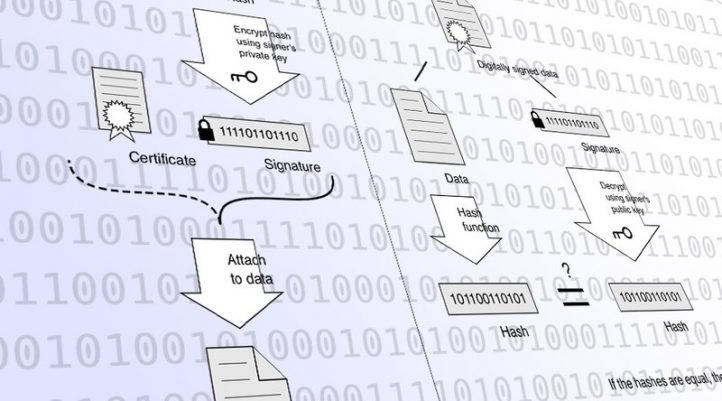Around Bitcoin Cash (BCH) there is a lot of talk about improvement, called “Schnorr Signatures.” We collected all of the most important features and benefits of this protocol in one article and described them in a language understandable to a wide range of people, without complicated terms and omissions, which are dazzled with existing articles on the subject of Shnorr signatures presented in the Russian-speaking segment of the Internet.
What is the signature of Schnorr?
Schnorr is called an improvement that adds a new transaction signature format to Bitcoin Cash (in the future, to other cryptocurrencies ). As you know, each transaction is signed using a private key, which means adding a special label as proof of the signer's identity. You can compare it with the stamped wax seal on old letters.
If you have a cryptocurrency wallet , you perceive it as a regular leather wallet, in which the cryptocurrency lies like paper bills. In fact, it is more correct to call a cryptocurrency wallet a “keychain” rather than a “wallet”. The word wallet, which is firmly entrenched in the subconscious of the masses, does not reflect the true essence and functions of such software. A “keychain” is the right image to help create the right view.
To sign any transaction need authorization. Or on the other hand, you need to take the correct key from the “keychain” and use it to open coins lying on one or another address.
During a transaction, the wallet (or “bundle”) uses one of the user's private keys to sign it. Each BCH address contains its own private key, which is different from the private keys of other BCH addresses.
Thus, if you have a private key for a specific address with coins, you can spend these assets by “signing” the transaction with a private key. In most wallets, the signature procedure consists in the user entering a password, while the signature is performed automatically by the wallet.
The Bitcoin protocol (BTC) uses standard signatures from a stack of cryptographic protocols used in the military industry, communications, data transmission over networks, etc. These signatures have proven to be a good means of protecting coins, but they are not perfect.
Signatures Schnorr reduce block size
Until recently, the signature of transactions in the Bitcoin Cash network was carried out using the ECDSA standard, which implies that each signature is about 70 bytes. Bitcoin uses the same standard, and a whole bunch of different forks like Bitcoin Gold , Bitcoin Diamond , Bitcoin Private and so on. Most of these forks have no special significance for the development of the industry and are used exclusively for market speculation. But this is a topic for a separate article.
Signature Schnorr raises the process of using "keys" to a new level.
- First of all, it takes only 64 bytes when it gets into the block, which reduces the space occupied by transactions by 4%. Since transactions with a Schnorr signature are of the same size, this makes it possible to estimate the total size of the part of the block that contains such signatures. And a preliminary calculation of the block size is the key to its safe increase in the future, regardless of the cryptocurrency used.
- Secondly, space is saved in multi-signature transactions. A multi-signature is when your cryptocurrency wallet sends a transaction, for successful confirmation of which several “signature keys” are needed (possibly from several people), not just yours. These signatures are taken either from your several own dispatch addresses. Or from the addresses of several people involved in the transaction. Previously, a transaction collected signatures from each person (or from each individual of your address) separately.
But if in a transaction to use the signature of Schnorr, then the set of signatures from different people is combined into one common "meta-signature". Undoubtedly, one signature is less than five or ten.
Thus, the space occupied by the signatures in the block and blockchain is significantly reduced. The developers of Bitcoin Cash, Omari Seshe and Mark Lundeberg, are confident that using Schnorr signatures can save 20-25% of the block space. Such savings could be achieved in Bitcoin if Schnorr’s signatures were introduced back in 2017, when a prominent developer, Luke Junior, thought about it. But nothing has changed since then, Bitcoin still does not have this standard, despite numerous promises.
Schnorr Signatures Improve Transaction Anonymity
A new type of signatures will not only save space, but also change the visible data of senders and recipients: the private and public keys of the sender or recipient can now be multiplied by 2, without losing their functionality.
This will change their appearance, and the outsider will not know which key was used to sign the transaction – normal or modified. In this case, the user fully reserves the right of ownership and will be able to send coins "in the old-fashioned way."
Also become available to the execution of the so-called "ring signatures" that improve privacy . Such signatures are a cryptographic tool that allows any person or group of people to join a network of users, then sign a transaction without having to disclose to the public who it was from this set of people / bots that did and send it to the network.
In the future, it will be possible to invent additional ways to use such transactions, but now they will significantly complicate tracking by hackers and intruders trying to identify you with your BCH assets.
Why did the sign of Schnorr appear in Bitcoin Cash, and not in Bitcoin?
Initially, this idea was driven by several Bitcoin Core developers, such as Luke Dash Junior, Chris Belcher, and so on. In addition to them, Omari Seshe, the leading developer of Bitcoin Cash client Bitcoin ABC, as well as his colleague from the BCH camp, programmer Mark Lundeberg, became interested in the idea. Since 2017, in each of the "camps" there were at least two interested programmers. Both camps promised the introduction of Schnorr signatures, as they are an important part of the development of decentralized protocols.
But why did the developers of the Bitcoin Cash network cope with the implementation task first? Despite the fact that many have been waiting for this from Bitcoin Core, as from an older and experienced team of programmers.
Over the past two years, significant changes have been made to the Bitcoin Core repository. But none concerns the further anonymization of transactions, just like the expansion of transactional capacity. The reason may be the fact that the substantial resources of Core are now aimed at creating and promoting third-party anonymization and scaling solutions, such as Liquid, SegWit or Lightning . Interestingly, all these protocols still contain a huge number of minor flaws.
It is possible that this is also due to the unofficial position of opinion leaders in the Core camp. And this position is such that Bitcoin has already “outgrown” the stage of digital cash, and should be perceived by people as “digital gold”. And gold, as you know, is not cash. This is a cumbersome asset with a low degree of use as a means of payment.
The average commission in the Bitcoin network, the transaction confirmation time, periodically increases, which makes the first cryptocurrency inconvenient in everyday calculations. You can never guess “for how many hours” one transaction will be confirmed. In addition, in recent months, low-commission transactions have been hanging for four days without confirmation, so using Bitcoin as cash for everyday transactions would be too inconvenient and expensive for most users.
The ideological background of the signatures of Schnorr
A large number of cryptocurrency exchanges and online wallets began to collect personal user data. They store in their databases all Bitcoin addresses associated with a particular online person. They track users by using cookies and other technologies, so the initially anonymous nature of cryptocurrencies is put at significant risk.
A number of companies (like Chainalysis and Crystal) have already created complex software for tracking user transactions and ranking addresses according to the level of legality of bitcoins on them. Signatures of Schnorr will help to return a decent level of privacy in Bitcoin Cash at the moment when the developers of Bitcoin Core “hang in the jacuzzi” and prepare to patch the next bugs of their commercial product SegWit.
Yes, this is a commercial product, because exchanges must pay developers for advice on its implementation. Nothing in this world is free, you should not believe in the ideology of “unprecedented generosity in the name of saving humanity”, which some of the main participants and mastodons of the BTC development love to hide behind.
Publication date 07/14/2019
Share this material on social networks and leave your opinion in the comments below.

